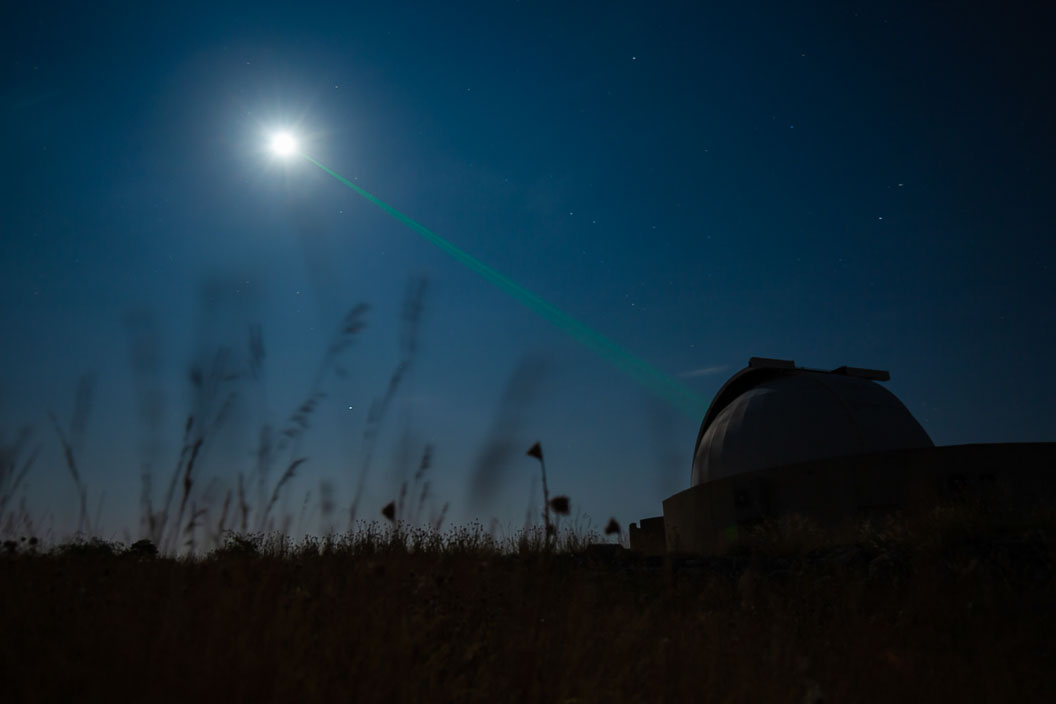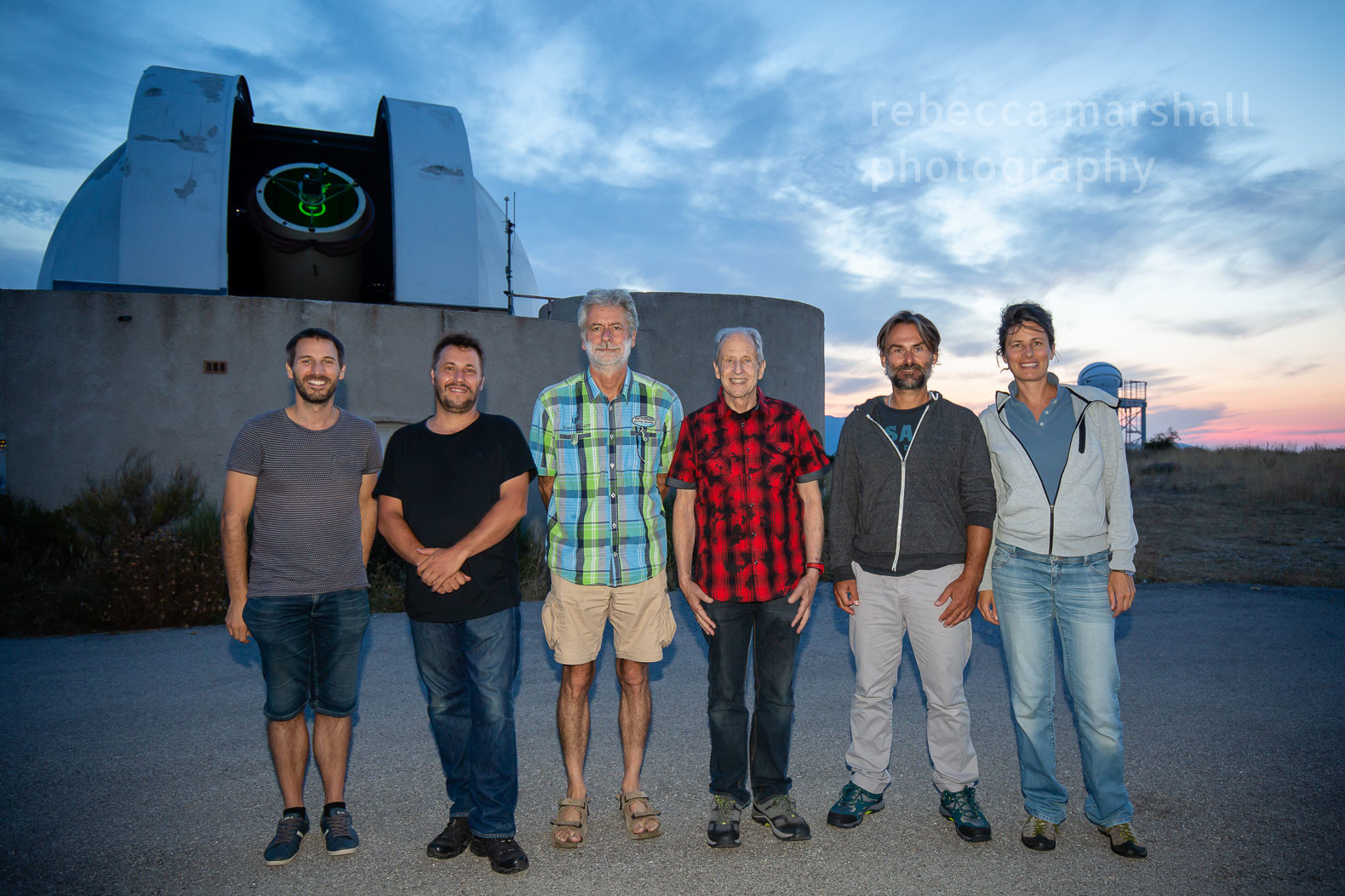I had a trip planned last weekend, but as soon I got a call about this Saturday night assignment, I knew that I would move mountains to make this reportage possible. It had it all: creativity, a giant laser, a middle of the night rendez-vous, an international space artist and a first of its kind event worldwide. How could a photographer possibly refuse? It would doubtless be the closest I’d ever get to space travel.
Man on the moon
Space artist Richard Clar came from his California home to the South of France on a mission. To mark the 50th anniversary of the first moon landing, Clar had created a work of art: ‘Giant Step‘. At 04:56:15 local time on Sunday 21 July, precisely 50 years after Neil Armstrong took his first step on the moon, the artist would send a message, via a giant laser, to a small reflector panel left on the spot where Apollo 11 had landed. The message would be a Morse encoding of the astronaut’s famous words, “That’s one small step for man, one giant leap for mankind“.
After an early evening snooze, I gathered up a more varied range of photographer equipment than usual and left for my day’s work, at 01.00 am. The sinuous mountain road winding up to the laser-ranging station, high above Grasse, was potentially hazardous. “Watch out for gendarmes” said a friend of mine, concerned about the time I might lose at a contrôle; “Watch out for wild boar” advised another, more concerned about my safety. Perilously sheer drops to the side of hairpin bends were clearly to be avoided too, as I climbed ever higher. On the final approach to the observatory’s domes on the rocky Plateau de Calern, the French Riviera below melted into distant silence. I turned off Sinatra’s ‘Moon River‘, the last track of my put-me-in-the-mood playlist, and government signs loomed out of the darkness instructing me to turn off my headlights.
I knew the spot by daylight, having hiked there from the other side of the mountain, and had marvelled at the extraordinary instruments, both old and new, scattered across the site of the Cote d’Azur Observatory. Being welcomed into the dome of the laser-ranging station was a whole other marvel.
Fly me to the moon
The control room didn’t look very space-age. It was quite small and not Côte-d’Azur-shiny at all. The shutters over the windows were all stuck, and paint was peeling off the walls above stacks of ring binders, beside which, two astronomers, clad in T-shirt and shorts, sat at work. However, the setting was irrelevant. What mattered was the live data displayed on the multitude of screens before them, generated by the gigantic laser whirring away in the room next door, its door plastered with warning signs.The dome above was where the magic was happening. A laser beam, generated with a lot of flashing instruments, electricity and jiggery-pokery downstairs, was being transmitted, via a system of mirrors and a gargantuan telescope, to the moon and back. Poking out through a slit in the roof, this telescope aimed the laser beam at the 45 cm wide Apollo 11 retroreflector on the surface of the moon. The dome itself rotated slowly to follow the moon’s path through the night sky (explained to me after I unwittingly leaned my hand on a ledge and it came away dripping with thick, dark lubricating oil). There are several laser-ranging stations worldwide, but few gather data from the moon, and this station is Number 1 for the task. 93% of data collected worldwide on the distance of the moon from the Earth is gathered at this obscure site in the South of France. Tonight would be the first time that the beam would carry an encoded message.
Unsurprisingly, the photographer and two videographers were closely chaperoned around the station, with its highly sensitive, dangerous and valuable equipment (a reminder of being chaperoned recently when photographing a €40 million car). However, it soon became apparent that the number of astronomers present wasn’t really sufficient to prepare the laser transmission, co-ordinate with the space artist, be interviewed on camera, and supervise a photographer. So it was that I found myself alone under the dome, peacefully taking long-exposure photographs of the great laser-ranger creature, who was blinking green and humming companionably alongside.
Goodbye moon
Data generated by the laser (to the moon and back travel time, measured in picoseconds) is used to track the distance of the moon from the Earth. Laser ranging can only happen in fine weather, as cloud and even atmospheric disturbance block the beam (which is partly why the sunny South of France was chosen as the station’s location). The exact time it takes for a laser signal to reach the moon, bounce off the Apollo 11 site reflector and return to the station (800 000 km) is a flabbergasting 2.6 seconds. While my middle of the night, tired brain struggled to process how the data has helped to confirm Einstein’s theory of relativity, to learn more about the Earth’s mass and to map the oceans more effectively, what I did clearly grasp is that the moon is moving, slowly but surely, away from us. This laser ranging station has been no stranger over the years to visits by TV teams, press photographers and journalists. The Cote d’Azur Observatory’s 35+ years of continuous data gathering proves irrefutably that the moon is leaving Earth, at a rate of 3.6 cm every year. Although they won’t be felt for a good few generations, the effects that a receding moon will have on our tides, and even our climate, are pretty thought provoking. Meanwhile, a control room screen showed the distance of the moon changing before my very eyes. The number of metres was whipping through at astronomical speed, but this didn’t represent change in the overall distance of the moon from Earth; rather, every 12 seconds, as it moved towards the horizon, the moon was drawing a kilometre further away from us, following its curvy, nightly path in the sky.
Sleeping satellite
Another use of laser ranging (less prominent in the press, and in this case discussed off the record between astronomer and photographer on a chocolate break) is to track satellites. Several thousand satellites, both commercial and state-owned, orbit the Earth for navigation, communications, weather forecasting and military purposes. It doesn’t take much imagination to see how a laser-ranger, capable of tracking distances and trajectories of known satellites, could be used for national intelligence. Indeed, the Cote D’Azur Observatory’s laser equipment is hired out from time to time, sometimes by the military, for strictly confidential reasons. My quip with the astronomer (who, as the station’s laser expert, is responsible for its supervision) that he is some sort of Cosmic Spy, may not have been so far off the mark.
Dancing in the moonlight
The moon was only a few days past full on Saturday, and the laser beam was harder to see (and photograph) than it would have been on a darker night. Yet inside the dome, where I took Richard’s portrait, the darkness was deeper. It was a rare experience to make a portrait where I couldn’t see the subject, and I had only a vague view of the scene, with little more than instinct guiding my directions. I’d abandoned my torch early on: each time I turned it on and back off, it took my eyes a long time to readjust and see anything at all, and I preferred to work in near-darkness. Richard was fortunately a great subject, following his photographer’s almost-blind instructions perfectly, and patiently holding still during the few 30 second exposures. In the final moments before the transmission, Richard played a truly unique piece of music, another element of his Giant Step artwork. Having come across an electrocardiogram that showed, in graph form, the activity of Neil Armstrong’s heartbeat at the moment of his landing on the moon, the artist had the idea of making it into music. Richard had worked with both a prominent American jazz musician and a Google data analyst to transpose this heartbeat data, along with Armstrong’s famous words, and the musical result was as evocative as it was strangely beautiful. The laser transmission itself took place in a matter of seconds. Shortly after photographer and videographers rushed outside to capture pictures of Clar with the moon, laser beam and observatory, a first glow on the eastern horizon surprised us all. The laser beam’s visibility suddenly faded, the moon lost its brightness and somehow, with the arrival of day, the spell was broken. However, for the six of us who were there, I suspect that the magic of that night will live on for some time…




Mary Kern
Jul 25, 2019 at 5:53 pm
What a wonderful account of this amazing event! Reading this story was the next best thing to being there.
Rebecca Marshall
Jul 30, 2019 at 5:56 pm
I’m so glad you were able to share somehow in the experience from a distance through my post 🙂
preslier
Jul 31, 2019 at 1:22 pm
merveilleuse histoire .chapeau Rebecca
Rebecca Marshall
Aug 6, 2019 at 1:23 pm
Merci Michel 🙂